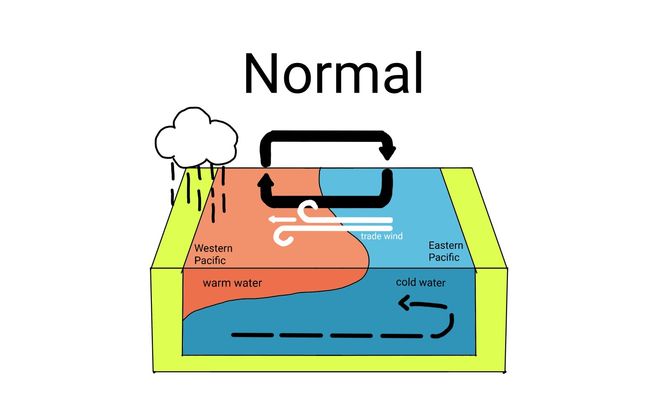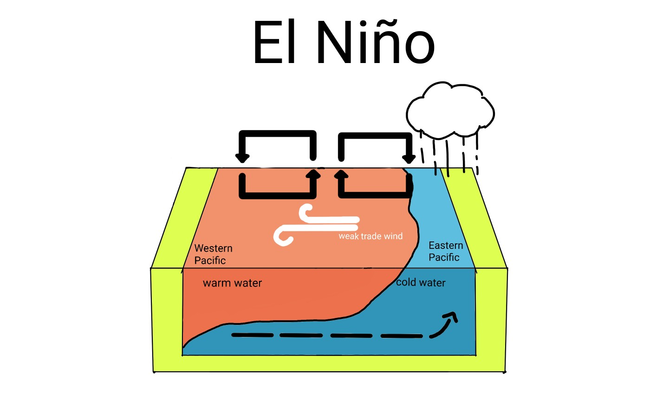Recently, extreme weather changes have been occurring frequently due to El Niño. In particular, the Atacama Desert located in Northern Chile is known as the driest place in the world. The climate there is extremely dry, with some areas receiving less than 1mm of average annual rainfall. However, during the 2015-2016 'Super El Niño' event, the Atacama region experienced rainfall equivalent to seven years' worth in just 12 hours. As a result, rarely seen flowers were in full bloom. An unusual natural phenomenon occurred, and the desert turned pink. We’re going to analyze the relationship between El Niño and global warming. We’re also going to examine the serious impact that climate change has caused.

El Niño is a climate phenomenon that happens when the sea surface temperature in the eastern equatorial Pacific becomes unusually warm. It means ‘Baby Jesus’ in Spanish, and it is used to describe the warm current that appears off the coast of Peru and Chile around Christmas time, making it harder to catch fish. As the damage continued, the climate phenomenon mentioned above eventually came to be known as El Niño gradually. When there is a pressure difference between the Eastern Pacific and the Western Pacific, it weakens the trade winds and changes the direction of ocean currents. It also affects sea surface temperature. Finally, it prevents the cold water in the Eastern Pacific from rising to the surface. This phenomenon typically occurs in cycles of 2 to 7 years and can last for several months. It causes various weather anomalies like heavy rainfall, drought, and temperature increases, because of the interaction between the atmosphere and the ocean. It has a significant impact on global weather.

El Niño is not just a change in sea surface temperature. The ocean and the atmosphere are closely connected, so the change in sea temperature affects both airflow and rainfall patterns. When this occurs, the frequency and intensity of typhoons tend to increase, as the sea surface temperature in the Western Pacific rises. During El Niño, the sea temperature near the equator rises. This creates an environment where typhoons easily form. Typhoons that occurr in the Northwestern Pacific are likely to move toward the Korean Peninsula. In fact, when the 2015 El Niño occurred, the powerful typhoons ‘Cha-Hom’ and ‘Goni’ affected the Korean Peninsula and they caused significant damage. Similarly, during the 1997-1998 El Niño, Typhoon ‘Yenis’ hit the Korean Peninsula hard. Meteorologists warn that a powerful El Niño combined with global warming is likely to cause stronger typhoons in the future. Also, when it occurred, as the sea surface temperature in the Eastern Pacific rose, it caused a worldwide temperature increase. It has also increased the amount of water vapor in the atmosphere, raising greenhouse gas concentrations. Water vapor is a potent greenhouse gas, so it can exacerbate global warming. In the years that the strong El Niño occurred such as 2023-2024, there were many cases where the global average temperature was high. The 2015-2016 Super El Niño, which had an unprecedentedly strong and widespread impact, is an example. Plus, the El Niño that occurred in 2023-2024 caused southeast Asia, including the Philippines and Thailand, to experience heatwaves exceeding 40°C in April. In April of that year, the perceived temperature in the Ipil region of Northern Philippines soared to 48°C, leading to a nationwide school closure and the implementation of measures such as a four-day workweek. Additionally, Thailand's power demand reached an all-time high. Scientists warn that global warming is increasing both the frequency and intensity of El Niño events. Since the late 20th century, the occurrence of El Niño has been becoming more frequent, and recent studies suggest that if global warming continues, the cycle of strong El Niño events is likely to shorten.
El Niño causes various problems not only in terms of climate but also in social and economic aspects. In regions near the Western Pacific, such as Australia and Indonesia, decreased rainfall increases the risk of droughts and wildfires, affecting agriculture and drinking water supplies. On the other hand, in the Eastern Pacific, including the western coast of South America, warm seawater intensifies atmospheric convection, bringing heavy rain to normally dry coastal plains and causing floods. Additionally, El Niño can worsen coral bleaching. Coral bleaching occurs when corals turn white due to higher-than-average temperatures, and if this continues, coral may die. These floods, droughts, and coral bleaching can lead to agricultural and fishery production declines, causing global food shortages and rising food prices. Economically, it results in massive losses across agriculture, fisheries, and other industries, and developing countries are especially vulnerable. Furthermore, extreme weather conditions increase the use of energy for cooling and heating energy, leading to energy supply instability and rising electricity costs.
Since climate phenomena like El Niño can be predicted, it is important to prepare effective countermeasures. At national and international levels, cooperation in climate change response should be strengthened, and climate prediction and early warning systems should be established. On a personal level, efforts should be made to reduce greenhouse gas emissions. About 93% of the heat from emitted greenhouse gases is absorbed by the ocean, raising seawater temperatures. Therefore, saving energy and practicing eco-friendly consumption are essential. Individual actions to reduce carbon emissions include using public transportation, recycling, and making environmentally friendly purchases. Additionally, small actions like saving water can help mitigate climate change. A strong El Niño is not just a temporary weather change but could be a warning sign of a climate crisis. Recognizing the seriousness of climate change and taking collective action at both personal and societal levels will help create a better future.
81st Reporter • AN KEUM HYUN • angeumhyun1@gmail.com
- TAG
-
 Freedom Given to Youth: An Opportunity for Choice or a Burden of Constraint?
“Are we truly free today?” Classical literature is far more than time-honored stories. It offers profound insights into human nature and society that transcend time, remaining a valuable resource for examining the challenges our world faces today. This article will draw on George Orwell’s 1984 and Charles Dickens’ Oliver Twist to explore the contemporary issues of youth housing and the emergence of a surveillance society ...
Freedom Given to Youth: An Opportunity for Choice or a Burden of Constraint?
“Are we truly free today?” Classical literature is far more than time-honored stories. It offers profound insights into human nature and society that transcend time, remaining a valuable resource for examining the challenges our world faces today. This article will draw on George Orwell’s 1984 and Charles Dickens’ Oliver Twist to explore the contemporary issues of youth housing and the emergence of a surveillance society ...

 [단신] 산악회, 본교 동문의 버팀목이 될 수 있도록
[단신] 산악회, 본교 동문의 버팀목이 될 수 있도록
 [사회메인] 노인 인구 1,000만 시대, 준비 없는 사회가 불안해
[사회메인] 노인 인구 1,000만 시대, 준비 없는 사회가 불안해
 [네컷만화] 라벨링 문화
[네컷만화] 라벨링 문화
 [진리터] 결국 우리 모두 돌아볼 것이니
[진리터] 결국 우리 모두 돌아볼 것이니

 목록
목록












